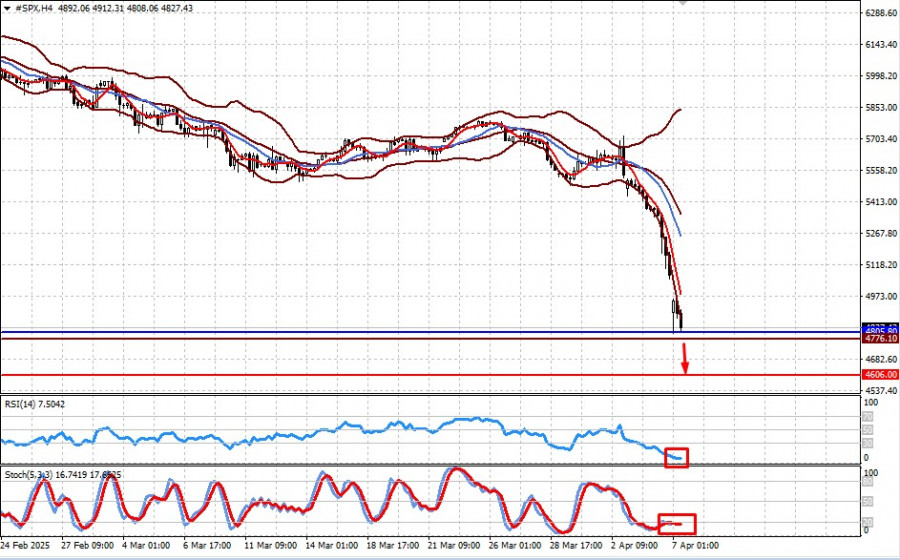See also


 07.04.2025 10:08 AM
07.04.2025 10:08 AMThe global market crash continues. The trade war declared by Donald Trump on much of the world is in full swing. Investors have stopped reacting to economic data, even though some of the latest figures are quite notable—though they may only worsen if the shock therapy intended to "cure" the U.S. economy fails.
And amidst all this worldwide chaos, an interesting picture is emerging in the U.S.—the country responsible for triggering this situation. Labor market data published on Friday was robust and positive. The number of new jobs in the non-farm sector came in at 228,000, far exceeding the forecast of 137,000 and the previously weak February figure of 117,000. Yes, the unemployment rate ticked up to 4.2% from 4.1%, but this is still manageable.
If we step back from the chaos affecting the financial markets—such as U.S. equity indices falling back to early last year's levels—we can see that strong job creation indicates the U.S. economy is still relatively healthy.
However, back to market dynamics: we must admit that asset prices have been unjustifiably inflated for years. The primary reason was an overwhelming amount of liquidity, or unbacked capital, pumped into the dollar-based financial system by the Federal Reserve to support demand and later bail out crumbling financial pyramids, starting with the 2008–2009 mortgage crisis. This liquidity spread worldwide and ballooned the U.S. national debt. That had to end at some point—and that's precisely what Trump is tackling now.
Excessively bloated stock markets, especially in the U.S., are clearly shown on the charts. Hardline shock therapy could lead to even deeper crashes. The S&P 500 could fall first to the 4,000.00 level, then down to 3,550.00. This wave of selling may also trigger reduced interest among retail traders in cryptocurrencies. For instance, Bitcoin could fall to around $60,000. Other tokens that have risen excessively could follow the same path.
As for the U.S. dollar, the ICE dollar index is unlikely to drop below 100.00 points. On one hand, the dollar supply in the financial system will significantly shrink, making it "scarce" and boosting demand. On the other hand, market panic and fears of a full-scale economic downturn in the U.S.—fueled by rising tariffs—will likely lead to higher inflation. This would not only prevent further rate cuts by the Fed but could also prompt rate hikes. In such a case, the U.S. dollar could strengthen again against all major currencies, possibly excluding the Japanese yen, which is supported by tightening monetary policy from the Bank of Japan.
We believe the flight from risk will continue. Investors will likely increase their purchases of government bonds from developed economies. Stock indices will remain under heavy selling pressure, as evidenced by the gap-down openings in futures markets. A similar pattern is expected in the cryptocurrency market. Meanwhile, the U.S. dollar is likely to consolidate against a basket of major currencies, supported by rising expectations of renewed inflation in the U.S.
The CFD contract for the S&P 500 index opened with a gap down on Monday. Continued bearish sentiment and a widespread flight to U.S. Treasuries could lead to a break below the 4805.80 support level and a renewed drop toward 4806.00 after consolidation. A possible entry point is at 4776.10.
The CFD contract for the NASDAQ 100 index also opened with a gap down. If risk-off sentiment persists and investors continue reallocating into U.S. government bonds, we could see a break below the 16,328.00 support level and a further decline toward 15,520.00, possibly after a brief consolidation or slight rebound. A potential entry point is at 16,205.60.
You have already liked this post today
*The market analysis posted here is meant to increase your awareness, but not to give instructions to make a trade.


Forex Chart
Web-version

Your IP address shows that you are currently located in the USA. If you are a resident of the United States, you are prohibited from using the services of InstaFintech Group including online trading, online transfers, deposit/withdrawal of funds, etc.
If you think you are seeing this message by mistake and your location is not the US, kindly proceed to the website. Otherwise, you must leave the website in order to comply with government restrictions.
Why does your IP address show your location as the USA?
Please confirm whether you are a US resident or not by clicking the relevant button below. If you choose the wrong option, being a US resident, you will not be able to open an account with InstaTrade anyway.
We are sorry for any inconvenience caused by this message.


